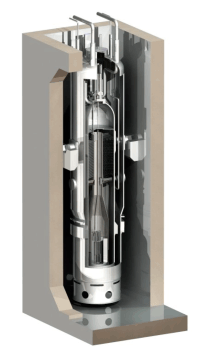forum
library
tutorial
contact

Hanford Offers Advantages for
Small Modular Nuclear Reactors
by Editorial Board
Bellingham Herald, January 8, 2014
|
the film forum library tutorial contact |

|
Hanford Offers Advantages for
by Editorial Board
|

It's encouraging to see economic development officials in aggressive pursuit of a role for Hanford in developing a new generation of nuclear reactors.
Hanford and the Tri-Cities offer an extensive list of advantages as a test site for building a small modular nuclear reactor system, but the nuclear reservation still is in danger of being overlooked.
The Tri-City Development Council is seeking bids to study the benefits of using Hanford for the project. It's a worthy endeavor. Hanford's selection would not only mean a major economic windfall for the Tri-Cities and the state, but also would reap benefits for the nation by capitalizing on the investment that taxpayers and ratepayers already have made in the Mid-Columbia.
The good news is that the nation appears committed to the idea. The Department of Energy already has announced $452 million in matching funds for two proposals to design and license modular nuclear reactors and plans to have the first small reactors operating in about a decade.
The new designs feature passive safety systems that automatically shut down the reactor during a power failure, eliminating the risk of the sort of accident that happened at Fukushima in Japan.
Babcock & Wilcox is working on one proposal in cooperation with the Tennessee Valley Authority. The other, by NuScale Power in Oregon, has tentative plans for an Idaho plant that would be operated by Energy Northwest of Richland.
But sites haven't been set in stone, giving TRIDEC time to convince DOE that Hanford is the best place for operating a small modular reactor.
Energy Northwest has completed a "soft analysis" that shows existing infrastructure at its never-completed WNP-1 reactor on Hanford land could save $50 million.
The site already has been issued a Nuclear Regulatory Commission permit, which might streamline the process for licensing a small modular reactor. There also could be additional cost savings by locating close to Energy Northwest's full-scale commercial nuclear power plant, the Columbia Generating Station, including in emergency preparedness, nuclear security, operator training and used nuclear fuel storage.
But Hanford's biggest advantage is the Mid-Columbia's people. Human assets include higher education nuclear training programs, a trained nuclear work force and companies and agencies that are providing support for other nuclear projects.
Building a small reactor at Hanford also enjoys broad political support. Last year, at Republican Sen. Sharon Brown's request, the Legislature earmarked $500,000 to study the possible creation of a new nuclear power industry at Hanford. That money will pay for the TRIDEC study.
Democratic Gov. Jay Inslee wrote to Energy Secretary Ernest Moniz in August, asking DOE to consider placing a small modular reactor at Hanford.
Most members of Washington's congressional delegation also have provided letters of support.
Hanford also offers a ready market for power produced by a small reactor. The electrical needs of the vitrification plant under construction to treat Hanford's high-level radioactive wastes require additional power.
The economic benefits for the Tri-Cities and state are obvious. A new small modular reactor, costing from $500 million to $1 billion, would create 200 to 300 construction jobs, then 100 permanent jobs to operate the plant.
But the real economic prize is the potential to be on the ground floor of a new industry.
The idea is to position the Tri-Cities for a role in manufacturing or at least assembling commercial small nuclear reactors, including for export. The Tri-Cities has access to ocean-going vessels to ship the reactors to China, Korea, Japan and developing countries.
The reactors are proposed to be built in factories and transported to sites where they would be ready to "plug and play" upon arrival, reducing capital costs and construction time. Models that would produce 45 to 200 megawatts have been proposed by industry, which would make them useable for small electric grids and locations that cannot support large reactors, offering utilities the flexibility to add more modules to scale up production if demand increases.
learn more on topics covered in the film
see the video
read the script
learn the songs
discussion forum
